June 12, 2018, 9:18 pm | by Ray Nardo
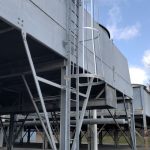 A common item found throughout many workplaces is the fixed ladder and it can be easily overlooked until the time comes when it is needed. We may pass by them each day without much thought, but when the time comes and the ladder is needed, we want to be sure we are protected. OSHA put out new safety guidelines in January of 2017 for all fixed ladder systems in the new Walking -Working Surfaces Standard to help provide more protection for you, the workers of America. All general industries are affected by the changes and revisions to the guidelines for fall protection systems and other safety features. Read more.
A common item found throughout many workplaces is the fixed ladder and it can be easily overlooked until the time comes when it is needed. We may pass by them each day without much thought, but when the time comes and the ladder is needed, we want to be sure we are protected. OSHA put out new safety guidelines in January of 2017 for all fixed ladder systems in the new Walking -Working Surfaces Standard to help provide more protection for you, the workers of America. All general industries are affected by the changes and revisions to the guidelines for fall protection systems and other safety features. Read more.
January 24, 2018, 3:39 pm | by Scott Daly
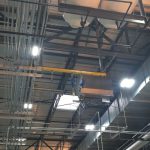 FallProof single point anchors provide a cost effective fall protection in manufacturing plants, distribution centers, steel mills, and other industrial facilities. Typical applications for single point anchors include manufacturing equipment maintenance, routine maintenance on elevated equipment, heavy equipment manufacturing, and processing equipment in food manufacturing. Other applications include access to tops of storage tanks, safe access to security cameras and other equipment mounted near a roof edge. Single point anchors also provided fall protection for workers where ceiling features such as pipes or air ducts prevent the installation of long run horizontal lifelines and rigid track systems. An often overlooked use of SPAs is to provide an anchor for a rescue and retrieval system which is required by OSHA as part of a complete fall protection plan. The single point anchor is a versatile fall protection application that offers a variety of solutions for different industries.
FallProof single point anchors provide a cost effective fall protection in manufacturing plants, distribution centers, steel mills, and other industrial facilities. Typical applications for single point anchors include manufacturing equipment maintenance, routine maintenance on elevated equipment, heavy equipment manufacturing, and processing equipment in food manufacturing. Other applications include access to tops of storage tanks, safe access to security cameras and other equipment mounted near a roof edge. Single point anchors also provided fall protection for workers where ceiling features such as pipes or air ducts prevent the installation of long run horizontal lifelines and rigid track systems. An often overlooked use of SPAs is to provide an anchor for a rescue and retrieval system which is required by OSHA as part of a complete fall protection plan. The single point anchor is a versatile fall protection application that offers a variety of solutions for different industries.
Read more.
June 13, 2016, 3:23 pm | by Ray Nardo
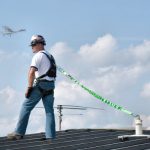 Fall protection anchor points are a versatile tool that with proper design, installation and use can protect workers in a variety of situations. Without all three of these factors being present, there is the possibility that a worker may have the illusion of being protected with the reality of being no more safe than working without any fall protection at all. Read more.
Fall protection anchor points are a versatile tool that with proper design, installation and use can protect workers in a variety of situations. Without all three of these factors being present, there is the possibility that a worker may have the illusion of being protected with the reality of being no more safe than working without any fall protection at all. Read more.
March 1, 2016, 12:50 pm | by Ray Nardo
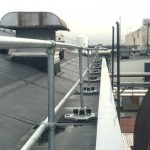 Numerous fall protection design and engineering challenges are presented for guardrail systems installation on multi-level rooftops. This article discusses the issues faced by designers, engineers and individuals responsible for the installation. Read more.
Numerous fall protection design and engineering challenges are presented for guardrail systems installation on multi-level rooftops. This article discusses the issues faced by designers, engineers and individuals responsible for the installation. Read more.
December 10, 2015, 4:43 pm | by Ray Nardo
Much Forethought Goes Into Proper Fall Protection Installation
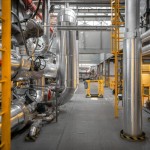 From a fall protection installation standpoint, the primary goal of the system being installed is to protect workers. The objectives are to get the right system, at the right price, installed on time and on budget, with minimal disruption to the normal activities of the business. Read more.
From a fall protection installation standpoint, the primary goal of the system being installed is to protect workers. The objectives are to get the right system, at the right price, installed on time and on budget, with minimal disruption to the normal activities of the business. Read more.
November 17, 2015, 9:53 am | by Ray Nardo
Pre-Plan Fall Protection On New Construction During The Design Phase
 For new construction projects, we are often asked to bid on procurement and installation of fall protection equipment. All too often, we find that it is treated as an afterthought, rather than an integral component of a well-designed building. We are alarmed whenever a contractor who has asked us to bid a project says, “They will add that later”, when we point out that the plans and specifications either say nothing about fall protection, or mention it without providing any scope, location or other layout information. Read more.
For new construction projects, we are often asked to bid on procurement and installation of fall protection equipment. All too often, we find that it is treated as an afterthought, rather than an integral component of a well-designed building. We are alarmed whenever a contractor who has asked us to bid a project says, “They will add that later”, when we point out that the plans and specifications either say nothing about fall protection, or mention it without providing any scope, location or other layout information. Read more.
August 28, 2014, 10:51 am | by Ray Nardo
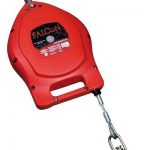 When discussing the effectiveness of certain types of fall protection equipment, there is a debate going on these days over which type of connector is best: self-retracting lifelines (SRLs) or 6-foot shock absorbing lanyards (the connector is the device that links the body harness to an anchorage, such as an overhead fixed track or single-point anchor points). It is our opinion that SRLs are the best type of connector. Yes, lanyards are less expensive, but SRLs provide more effective fall protection, and are worth the extra money you spend. Read more.
When discussing the effectiveness of certain types of fall protection equipment, there is a debate going on these days over which type of connector is best: self-retracting lifelines (SRLs) or 6-foot shock absorbing lanyards (the connector is the device that links the body harness to an anchorage, such as an overhead fixed track or single-point anchor points). It is our opinion that SRLs are the best type of connector. Yes, lanyards are less expensive, but SRLs provide more effective fall protection, and are worth the extra money you spend. Read more.
April 11, 2014, 2:18 pm | by Ray Nardo
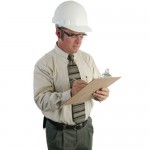 As a facility manager in charge of worker safety on elevated job sites, it’s important to understand the differences between OSHA regulations and ANSI standards when developing your fall protection program.
As a facility manager in charge of worker safety on elevated job sites, it’s important to understand the differences between OSHA regulations and ANSI standards when developing your fall protection program.
By understanding these differences, you are better able to:
- Avoid stringent fines for non-compliance;
- Reduce fall hazards and related accidents;
- Improve worker safety and productivity; and
- Decrease lofty workers’ compensation claims.
Read more.
March 28, 2014, 2:49 pm | by Ray Nardo
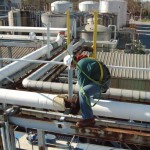 Conducting annual lifeline inspections goes hand in hand with proper training of your workers. Your equipment isn’t protecting anyone when it has missing, worn or defective components. Worse, it can create an unwarranted illusion of security. Installing fall protection equipment in your workplace is a great first step towards keeping your employees working at heights safe from fall hazards. Read more.
Conducting annual lifeline inspections goes hand in hand with proper training of your workers. Your equipment isn’t protecting anyone when it has missing, worn or defective components. Worse, it can create an unwarranted illusion of security. Installing fall protection equipment in your workplace is a great first step towards keeping your employees working at heights safe from fall hazards. Read more.
March 14, 2014, 3:59 pm | by Ray Nardo
 While a comprehensive or strategic fall prevention or protection plan is certainly admirable, advantageous and the right long-term solution, it’s not always practical to implement all at once. The implementation of a complete solution is often a costly and time-consuming undertaking.
While a comprehensive or strategic fall prevention or protection plan is certainly admirable, advantageous and the right long-term solution, it’s not always practical to implement all at once. The implementation of a complete solution is often a costly and time-consuming undertaking.
Do you have to implement a comprehensive solution all at once, or piecemeal the installation? Read more.
 A common item found throughout many workplaces is the fixed ladder and it can be easily overlooked until the time comes when it is needed. We may pass by them each day without much thought, but when the time comes and the ladder is needed, we want to be sure we are protected. OSHA put out new safety guidelines in January of 2017 for all fixed ladder systems in the new Walking -Working Surfaces Standard to help provide more protection for you, the workers of America. All general industries are affected by the changes and revisions to the guidelines for fall protection systems and other safety features. Read more.
A common item found throughout many workplaces is the fixed ladder and it can be easily overlooked until the time comes when it is needed. We may pass by them each day without much thought, but when the time comes and the ladder is needed, we want to be sure we are protected. OSHA put out new safety guidelines in January of 2017 for all fixed ladder systems in the new Walking -Working Surfaces Standard to help provide more protection for you, the workers of America. All general industries are affected by the changes and revisions to the guidelines for fall protection systems and other safety features. Read more.









